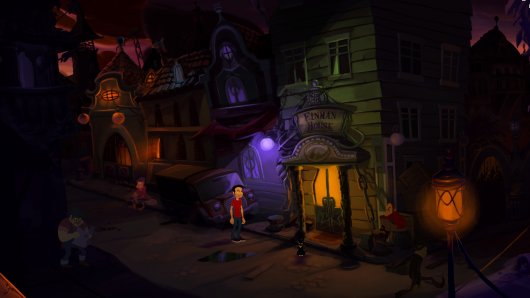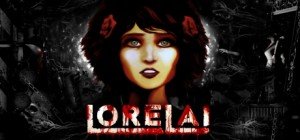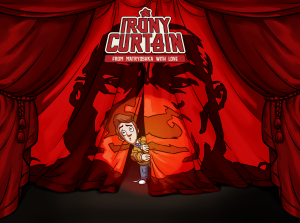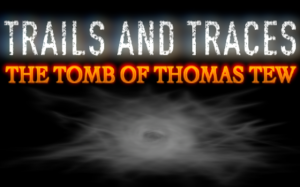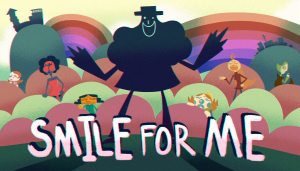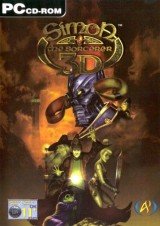Review for Gibbous: A Cthulhu Adventure

Created by a handful of folks from Transylvania calling themselves Stuck in Attic, Gibbous: A Cthulhu Adventure has been hotly anticipated ever since it was successfully funded on Kickstarter back in 2016. Inspired by the works of weird fiction writer H. P. Lovecraft and the LucasArts genre classics, Gibbous promised beautiful artwork, an otherworldly storyline, ample dialogue and laughter aplenty. Fast forward just over three years and the game is hitting digital shelves having met all of those objectives, though to various degrees of success. There’s no doubt that this admirable point-and-click debut effort has been made with love: it’s visually superb, begins intriguingly, provides some humorous moments and has a number of clever puzzles. Unfortunately, it’s undermined by dodgy writing and seems more interested in fantastical ideas than a comprehensible plot, creating an uneven experience overall.
The game begins with players in the shoes of the amusingly named Don R. Ketype. He’s a trench coat-wearing, tough-talking detective who has been tasked with hunting down the Necronomicon, an ancient grimoire that mysteriously seems to be in hot demand. His search has led him to the local library in a creepy “hellhole” called Darkham. Sitting behind the desk is a young man named Buzz Kerwan, who claims to know nothing about the magical book. That soon changes when the building explodes, Don is kidnapped, and Buzz discovers that the Necronomicon has been hidden a meter away from him this whole time.
In disbelief, Buzz takes the book back to his cramped home and reads it out loud – unexpectedly gifting his cat the power of speech. Well, “gifting” is debatable, since Kitteh (a bad name reminiscent of internet memes) is entirely unimpressed and wants to focus on eating and sleeping rather than talking. And thus it becomes Buzz’s mission to restore Kitteh’s meows and rescue Don. It’s an enticing opening that immediately pulled me in, posing lots of questions (like who took Don and the true purpose of this book) that made me keen to play on.
Sadly, it’s all downhill from here story-wise. The major issue is that it’s decidedly unfocussed. Buzz goes to visit a local voodoo expert for advice, who blabs on about a “terrible god of the murky abysses” called Bob Olmstein who lives in nearby Fishmouth and might be able to help reverse the magic. From this point onwards, I lost grip on what was happening. You eventually meet the person who employed Don to find the Necronomicon; he dumps meaningless exposition on you, talking in elusive riddles and mentioning things like “the Esoteric Order of Dagon” and some supposedly sinister guy called “the Butcher” before telling Buzz to find his daughter Peace.
I don’t know if I was just being an idiot, or if my lack of Lovecraft exposure was a hinderance, but I had no idea what was going on and my confusion continued to spiral. Buzz and Don finally meet up again; the former decides to head to Romania to find Peace, the latter to immortal alchemist Nicolas Flamel’s abode… for some convoluted reason. The narrative incoherence is incredibly frustrating and it comes across like the writers had all these exciting ideas and didn’t know how to blend them together into a meaningful plot. At times it seemed like I’d missed entire chunks of the game that were meant to contextualise things. I found it impossible to properly engage with the wider story – something about monsters and cults – as a result. The last third of the game is particularly problematic, introducing unexplained new characters and concepts on a whim.
It doesn’t help that parts of the dialogue are poorly written and sometimes don’t entirely make sense, though you can figure out the gist. “I put some weight on my man in rare and forbiddens – the kinda pressure makes a Joe’s stomach jackflip,” says Don in the opening. Most of the time it’s passably fine, but some conversations can be clunky and verbose. Certain lines sound as if they’ve been mistranslated – shoes being called “walk-dogs” at one point totally threw me.
That’s not to say the script is all bad. Far from it. There are a lot of wonderful, funny moments: a cultist’s refusal to complete a sacrifice without filling out the necessary paperwork; the Fishmouth tourist information employee saying the best thing a visitor can do is leave; pop culture references like Darkham Asylum described as being run by a real joker; and ironic RPG-style stats appearing above Buzz when he does something particularly silly or clever. “Man, this is just like in the movies,” Don quips as he patiently stands around waiting for Buzz to look something up on a laptop. Gibbous succeeds in bringing the humour out in bizarre moments, so it’s a shame that such unusual events aren’t tied together better.
Despite being inspired by Lovecraft, Gibbous is not intended to be scary. The overarching story is played straight, and the often sombre art and music reflect that, but ultimately the game is more interested in making you laugh. Characters behave appropriately emotional during occasions that require it, such as when Don encounters some gruesome creations, but there’s always a light-hearted line or moment waiting around the corner. And though there are certain elements that would be unsettling out of context, like the owner of an inn having a hunger for his guests, such things are meant to be silly here.
Really the game works best on a micro level. Don and Buzz are rarely together (which is too bad because they have a good dynamic), so you control each character in turn with no agency in choosing between them. Usually you’ll need to convince people to let you through or solve their problems in order to progress, and it’s enjoyable tackling these quandaries through a mix of dialogue puzzles, inventory usage, and environmental manipulation. One scenario sees Don piecing together clues to convincingly pretend he knows someone, while another has Buzz posing as an entertainment act to stroll past a pair of festival guards. The highlight tasks are those most out of the ordinary, like cracking a password linked to a pentagram or decoding an unintelligible alphabet. The puzzles are never overly challenging but the difficulty does fluctuate, which makes for an uneven experience. The penultimate chapter is one of the easiest, which feels unnatural. Buzz can talk to Kitteh for a general objective reminder, but if you get stuck at any point you can handily consult Don’s notebook, which will update with hints.
As well as picking up items from your surroundings and combining some of them in inventory, Buzz can also employ Kitteh to help him out, typically to reach a ledge or hatch. Don is without feline support, instead acquiring a power called Resonance. This can be used on objects to investigate their past and learn what someone has said in relation to them. The best example of this is when you first get the ability and hear what the removal men in Don’s office had to say about some of his furniture and life choices. This ability is necessary to solve puzzles, but it is oversimplified to the point that you might examine an object or try to pick it up, only to have Don remark that he should use his Resonance on it instead. At other times I would often use the power on something and Don wouldn’t be able to detect anything from the past, which felt unsatisfying.
Regardless of who you’re controlling, moving around the world is as simple as clicking the mouse. Double-click and you’ll go faster, or even teleport to the next screen if you do it on an exit. And how to interact with hotspots, you ask? You click, of course, for a choice of look and interaction icons. Nice and efficient. You can examine loads of stuff in the environment, and you can do it multiple times to hear different things. I always interact with everything I can to see and hear everything on offer, so at first I liked this idea. However, as the game went on I found it a bit annoying to repeatedly click on the same hotspot, especially when the character would merely say something dull like “tick tock” about a clock or “intriguing” when looking at a window. Not exactly spicy dialogue, and it sometimes felt like it was written for the sake of it. It doesn’t appear to be necessary to click on anything more than once, but I was always concerned I might miss something important if I didn’t. Much more impressive is that you will nearly always hear a unique line when trying to combine items or use them on something, rather than getting a standard “I can’t do that” type of response.
Speaking of speaking, the voice acting in Gibbous is a textbook example of a mixed bag. I found Buzz’s voice to be grating and whiny, though good at conveying authentic fear or confusion. Although stereotypical for a detective (as his name would suggest), Don’s is much better, delivered in gruff tones that fit the noir-tinged role. Kitteh is great too, successfully selling her sarcastic and exasperated personality. There’s an array of accents throughout, some of which are believable to my ear (local Romanian bar owners) but others less so (a French hotelier). I believe a lot of the actors performed multiple roles too, since many secondary characters sound similar. Some are also miscast or have been given poor direction, like a coach driver who talks with unnatural pauses or a little boy who sounds like a middle-aged woman. I occasionally skipped through the dialogue once I’d read the subtitles, which I rarely do, just because I’d heard enough.
The absolute highlight of Gibbous is the wonderful 2D artwork and animation. It’s clear that a lot of time and care has gone into the aesthetic and it pays off richly. It’s consistently beautiful, reminding me of a Disney cartoon where characters are drawn in clean, colourful shapes and move with big, expressive motions. There are too many examples to list, but Don making inventive use of a fire extinguisher or Kitteh crashing into the ceiling are particularly delightful and humorous. You can even see the characters interacting with hotspots instead of being limited to a generic animation. Excellent smaller touches abound, like someone leaning back to get a better look at something up high, Don leaning on desks or chairs, and Buzz kneeling when talking to kids. Perhaps the biggest treat are the numerous cutscenes interspersed throughout, offering even more detail and fluid animation.
The same level of quality is true of the meticulously hand-painted backgrounds, ranging from a grand looming castle to a grimy ship dock to the rolling hills of Transylvania. The entire game takes place at dusk or late night, opting for deep blues, browns and red-purple hues, which creates a rather serious, gloomy feel that nicely contrasts the humour. Scenes are packed with detail: a medieval-style tavern is inviting and warm with its candle chandelier and ornate hanging jugs, while a makeshift prison feels dank with its peeling wallpaper and exposed pipes. Many of the buildings have weird proportions or jut out at impossible angles, which adds to the fantastical vibe. The world feels alive too, with flickering lights, pouring rain, and huge overbearing clouds circling overhead. My only criticism would be that some backgrounds are too dark, even with my monitor on the highest brightness setting, but handily you can hold the spacebar to highlight all hotspots.
Musically Gibbous makes ample use of strings and piano. It’s effective, but it does start to blend together and become a bit forgettable. At the beginning of the game the score is slower-paced, helping to build a suitably mysterious atmosphere. The soundtrack works particularly well in some of the more reflective scenes, like the violins that play against a dreary Paris backdrop. The tavern piece is looser, being the closest thing the game has to a carefree and cheery tune. Overall it works well as background accompaniment, though a bit more variety wouldn’t have gone amiss.
I won’t spoil anything, but I was as unsatisfied with the ending as I was with the confusing story arc leading up to it. The only redeeming element is some fancy visual flourishes that tie into a newly introduced gameplay mechanic. Apart from that the whole sequence seems rushed, like more had been intended but was dropped later in development. Not only do you get weighed down with more convoluted monologuing at the climax, but things aren’t adequately wrapped up. Emotional notes feel rushed and unearned, with no chance for characters to cool off and reflect on what just happened. The game just ends, complete with a left-field cliffhanger. While I’d gladly spend more time in this world, the promise of more to come shouldn’t come at the expense of providing enough closure to the matters at hand.
Clocking in at around ten hours if you explore everything, the play time is a commendable length for a small development team in their debut release. There’s a nice line of humour running throughout with some decent puzzles to solve, and of course the art is an absolute standout. But regrettably I came away feeling disappointed in a game that clearly has so much talent and many good ideas behind it. Lovecraft aficionados may get much more out of it than I did, but even so, it would have strongly benefitted from a tighter script that doesn’t (presumably) presuppose an in-depth knowledge of the Cthulhu mythos to appreciate. Gibbous is a decent first effort, to be sure, let down more by grand ambition than a lack of obvious potential, so hopefully Stuck in Attic follow up with a sequel that soars to greater heights.
WHERE CAN I DOWNLOAD Gibbous: A Cthulhu Adventure
Gibbous: A Cthulhu Adventure is available at:
- GOG -80%






